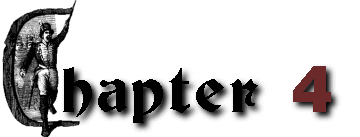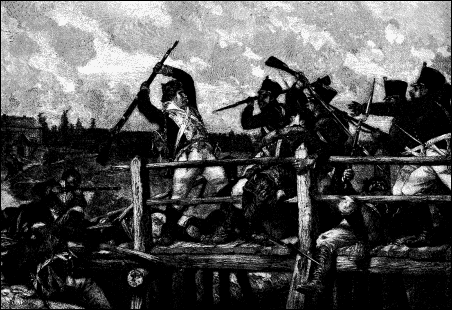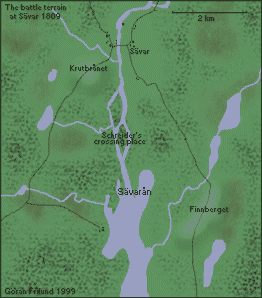
With the main army defeated, Klingspor and Adlercreutz began the second retreat north. No larger engagements were fought but the Russians again tried to cut off the retreat as they went to attack at Kronoby near Kokkola (Gamlakarleby) on September 15 but this plan was soon destroyed as the Swedes won a victory in the area. On September 29 the cease-fire of Lochteå was signed on Russian initiative and after this Klingspor finally left over the command of the army as general Klercker took over. The continued retreat was a tragic sight. The Swedish troops were suffering from diseases and their equipment was insufficient. These circumstances finally broke the army down.
On the eastern theatre of war, the Russians broke the treaty of Lochteå when they on October 27 attacked Sandels and his fifth brigade at Koljonvirta (the battle of Virta bro), the battle that followed is of legendary status in Finnish history, mainly due to the treatment it gets in Fänrik Ståls Sägner.
More than 5.800 troops came against Sandels who had only 1.800 and found himself being at a desperate disadvantage. He had found himself a good position for the defensive action that was to take place though, and the Russians had to cross the bridge at Koljonvirta - also called Virta bro - to get to the Swedes. The Russians came over under screams and with playing music, their attack was total. But keeping his coldness, Sandels waited for the right moment. And then the order was given. With shining bayonets the Vasa regiment and Savolax jaegers went to the attack; they were followed by a battalion from Uleåborg as well as Karelian dragoons. The success was total. The Russian troops were turned over in rout and defeat; they were driven back towards the bridge. The Swedes brought them hard losses as they fullfilled bayonet-charges and let their weapons play against the confused formations of Russian soldiers. The Russian commander, Tutjkov himself was wounded in the battle.
The battle of Virta bro was the last Swedish military victory on Finnish soil.
Shortly thereafter the convention of Olkijoki was signed, on November 19, which stated that the Swedish armies were to leave Finland. The war was brought into northern Sweden and Finland had been left to Russian occupation. But the war was not yet over, the operations would continue in northern Sweden for some time, and Finnish soldiers there fought alongside the Swedish for the last time in the history of the Swedish-Finnish union.
Operations in Northern Sweden
The war continued on into northern Sweden and in March of 1809 the Russians made raids against he Umeå area, marching over the ice on the Sea of Bothnia from Finland. Against them stood the Swedish Northern army. Under the spring and summer of 1809 the military actions in northern Sweden were delayed by the fact that both sides expected a peaceagreement very soon, especially as the government in Stockholm under Gustav IV had been overthrown. This peace took its time though and there still were a couple of interesting actions to be fought.

In August of 1809 Swedens last expedition of the war against Russia was mounted and it certainly was a daring plan that was being executed. The Swedish army mobilized the last unit capable of carrying the fight to the enemy. The plan was to surround the Russian army under Kamenskij inside the town of Umeå by landing this unit behind enemy lines, while general Wrede would go to attack at the same time from the south of the town. The armies for the expedition were to be commanded by general Gustaf Wachtmeister, while the navy transporting the troops were under the command of admiral Johan Puke. On their way to the battlefield, the smaller ships transporting the troops were towed by the two ships of the line as well as a frigate that joined the expedition.
On August 17 1809, the forces arrived at Ratan, outside Umeå, where a thick fog effectively covered the attackers. The landing of the troops went as according to plan and the next day, the landtroops started the march upon Sävar. On the night between the 17th and 18th Swedish captain Nordenskiöld led an attack against Umeå itself with his nine gunsloops. He shelled the bridge over the Umeå river but was not able to destroy it as he was met by hard Russian artilleryfire. Wachtmeister did not do a thing to assist him, although the explosions were heard to Sävar, and so Nordenskiöld returned out to sea after his failed mission. On the morning of the 19th the troops were attacked by 6.000 Russians in Sävar.
The battle of Sävar was the second largest battle of the entire war. At about 7:30 in the morning of August 19, the fighting started as the Swedish avantegardes came under fire by the attacking Russian troops. The fighting was concentrated to "Krutbrånet", a mountain, over which the battle was waged time after time. The Swedish troops stood fast, although untried soldiers were thrown in. The Russians on their side, although suffering from hunger and being tired fought very well. As the Russian 23 jaegerregiment was on the offensive in the wood terrain just north east of the battlefield and Kamenskij found that they were moving too slowly, he let his own guns shoot away two shots in the back of them. This was how Russian commanders ruthlessly could use their powers.
General Anselme de Gibory (who was of French descent and had also been present at the capitulation of Sveaborg) had crossed the small river that effectively divided the battlefield, with nine companies Russian troops and was at this point threatening the Swedish right flank. Against these troops Wachtmeister committed the jaegerbatallion of the second brigade, Drottningens Livregemente as well as Svea Livgarde. Although the Swedish units were put in one by one, and could not develop the full strength of a collective attack, they finally beat the Russians off.

At Sävar the Russian troops were at this moment winning and the Swedish were retreating over the river. The Russians now found a splendid chance to beat the Swedish in the back and under Schreider, six Russian companies passed over the river and attacked the Swedish troops in the back that were fighting Anselm de Gibory. This all made Wachtmeister somewhat uncertain and he now gave the order of all-out retreat. Although the Swedish army still had five battalions in reserve, the retreat was started under complaints from the troops. The Russians were too tired to follow, but Wachtmeister had thrown away a perfectly good victory. The battle ended about 3.00 in the afternoon.
Wachtmeister retreated back to Ratan where he was protected by the large artillery of the navy, as well as from guns that had been placed on the beaches and nearby islands. Kamenskij followed and on the next day, the 20th of August, he attacked without fear. The Russian troops were cut to pieces in the hellish artilleryfire that followed. "The treetops were cut all the way to Djäkneboda", Allan Sandström tells us in his book "Sveriges sista krig", such was the artillery fire. Wachtmeister shipped out on the 22nd of August after Kamenskij had made some groundless threats and totally mislead the Swedish generals.
In the meantime Sandels had fought the Russians with success at Hörnefors a bit south of Umeå, where he again showed his brilliance in defencive actions. Other than this, general Wrede did not do much to support Wachtmeister in the north, they both expected the other to take the initiative. This was the main reason the plan failed.
"If so my position was very critical, I shall do everything in my power to bring my troops therefrom. Although I must agree upon the fact that it was very sad to retreat from a victory like this, which we had won in the last two days, in which I not only did beat the enemy and chased him out to his boats, but also personally placed him upon these boats, so to speak", Kamenskij reported to the Czar about the actions of Sävar and Ratan.
And with these words ended Sweden's last war.
Previous chapter<<<>>>Next chapter
Back to The Final War Chapters
© Göran Frilund 2000-03, All Rights Reserved.
If you've surfed onto this page from outside and there is no menu on the left,
CLICK HERE for the full Website.



